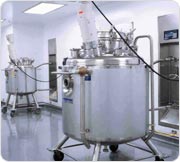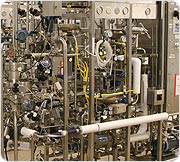
Start up and Commissioning
Introduction to Start up and Commissioning

EXPLANATION OF KEYWORDS
Start up is defined as the series of events required to turn equipment or systems on for the first time. Special care and precautions should be taken for all startups to protect not only the systems and equipment but any personnel working in the vicinity of the system or equipment. This activity should be performed with a series of checklist to verify and document the equipment or system is safe to start up or operate. Utility verification, valve alignment and motor rotation are items typically verified on a startup checklist.
COMMISSIONING is defined by the ISPE Commissioning and Qualification Guide as: “A well planned, documented, and managed engineering approach to the startup and turnover of facilities, systems, and equipment to the end-user / customer that results in a safe and functional environment that meets established design requirements and customer expectations.”
- Commissioning is performed under Good Engineering Practice (GEP) which is defined as: “Proven, accepted methods that ensure that engineering solutions meet end-user / customer requirements, are cost-effective, compliant with current regulations, and are well documented.”
QUALIFICATION focuses on features and functions with GMP impact and is developed in an authorized formal report and acceptance format. Qualification procedures and tests are written with regulatory compliance, future auditors, and FDA in mind.
Commissioning vs. Qualification
The first part of any successful facility startup is to identify the expectations of commissioning vs qualification and how the two will be performed together. Once you have identified this you can clearly identify everyone’s roles, responsibilities and deliverables during the start up & commissioning phase. It must be understood that each group from the engineering and design teams to the construction manager, trade subcontractors and suppliers must provide accurate documentation and timely support of any discrepancies or issues found. It is also very important to identify who will consolidate the information from all parties into the turn over package used for commissioning and qualification activities.

COMMISSIONING includes system or equipment start-up, adjustments, fine-tuning, cycle development, testing, installation, and documentation flexibility. When commissioning is performed and completed correctly, the system or equipment will be in a “State of Control”, which ensures the system or equipment is ready for formal qualification, testing, and approval. Commissioning tasks supplement the validity and regulatory compliance during qualification of GMP systems and equipment. Commissioning is not performed under the same authority and control as qualification, therefore the same rules do not apply to both tasks performed. It is very important to understand and leverage this to maximize efficiency from commissioning through qualification. Change control and the extra approval processes will slow things down.
- Systems with no product impact (Engineering) – Commissioning may apply.
- Systems with indirect product impact (Engineering) – Commissioning does apply.
- Systems with direct product impact (Engineering & Quality Assurance) – Commissioning and Qualification apply.
QUALIFICATION includes the following for GMP Critical Impact Only:
- Design Qualification (DQ) is the documented verification that the premises, the supporting utilities, the equipment, and the processes have been designed in accordance with the requirements of GMP. The compliance of the design with GMP should be demonstrated and documented.
- Installation Qualification (IQ) is the documented verification that all aspects of a facility, utility, or equipment that can affect product quality adhere to approved specifications (e.g. construction, materials) and is correctly installed.
- Operational Qualification (OQ) is the documented verification that all aspects of a facility, utility, or equipment that can affect product quality operate as intended throughout all anticipated ranges.
- Performance Qualification (PQ) is the documented verification that all aspects of a facility, utility, or equipment that can affect product quality perform as intended meeting predetermined acceptance criteria.

Commissioning Team Responsibility
- Work with project construction manager, vendor, and end-user / customer to help facilitate QA activities of others.
- Develop and execute commissioning procedures and documentation.
- Final installation of system / equipment.
- Track discrepancies and issues, help troubleshoot, and re-test if required.
- Develop calibration and preventative maintenance procedures.
Supplier / Vendor Responsibility
- Fabrication Quality Assurance
- Welding Quality Assurance
- Hydrostatic Tests
- Bench Calibrations
- Mechanical and Electrical Checks
- Integrator Software Quality Assurance
- Initial Cleaning, Passivation, and Flushing
- Factory Inspections and Testing (FAT)
- Support Documentation (TOP or ETOP)
- Instrument List / Materials of Construction / BOM
- As-built Drawings
- Installation, Operation, and Maintenance Manuals
- Start-up Support
Qualification Team Responsibility
INSTALLATION QUALIFICATION (IQ)
- Develop a controlled documentation and turnover package that will be presented to the FDA for approval following cGMP guidelines.
- Evaluate what was tested and referenced during commissioning and determine what will be developed or repeated.
OPERATIONAL QUALIFICATION (OQ)
- Evaluate what was tested and referenced during commissioning and determine what will be developed or repeated.
PERFORMANCE QUALIFICATION (PQ)
- Evaluate what was tested and referenced during commissioning and determine what will be developed or repeated.
Summary
- COMMISSIONING checks to verify the system or equipment is built to design specifications, operates correctly, and prepares for qualification.
- QUALIFICATION double-checks and validates the engineering and quality that was used to build or put together the critical features of the system or equipment and verifies that the final result will be defendable to the FDA during “Validation”.
- COMMISSIONING & QUALIFICATION together are tools used for project success and regulatory compliance. If commissioning is poorly performed, plan for more time during the validation / qualification of the system or equipment.
